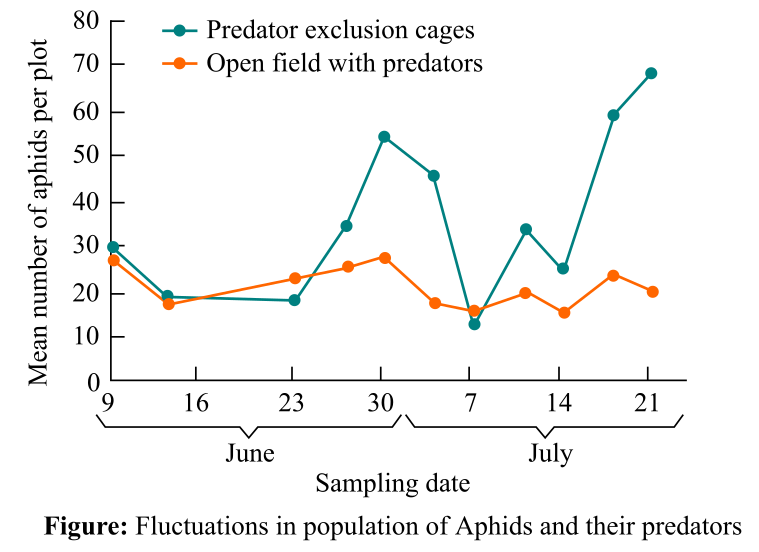
Concept explainers
To review:
The type of species interaction that appears to have caused aphid population to fluctuate in size in the Figure 1, and the type of species interaction that keeps the
Given:
The fluctuation in population of Aphis glycines (soybean aphids) is more when its predator, Orius insidiosus (insidious flower bug), is excluded from environment. When the predator is present then fluctuation in aphids’ population is less. This information is represented in the following Graph 1:

Graph 1: Fluctuations in population of Aphids and their predators.
Introduction:
Population of some organisms differs over time and some show very fast life cycle. In population that has very fast life cycle, fluctuation in its population occur within a few minutes or days. The highly fluctuating species responds to changes that occur in their
Want to see the full answer?
Check out a sample textbook solution
Chapter 54 Solutions
Life: The Science of Biology
- Looking at Figure 1 above, do locations that have a history of Paralytic Shellfish Poisoning typically have a population with a higher frequency of sensitive or resistant clams? Speculate as to why.arrow_forwardThe principle of competitve exclusion states thata) Competition between two species always causes extinction or emigration of one species.b) Two species will stop reproducing until one species leaves the habitat.c) Two species cannot coexist in the same habitat. d) Two species that have exactly the same niche cannot coexist in a community.arrow_forwardSpecies 1K1 (Carrying capacity of Species 1) = 1,000r1 (Intrinsic rate of increase of Species 1) = 0.02 Species 2K2 (Carrying capacity of Species 2) = 400r2 (Intrinsic rate of increase of Species 2) = 0.05Which one will recover from disturbances more quickly? Species 1 Species 2arrow_forward
- Meta population models focus on the BIDE (birth, immigration, death, emigration) dynamics, colonization and extirpation. A) Explain how these relate to genetic bottlenecks and explain why meta population models have a hard time predicting such events? B) Why is the island biogeography model a strong example of meta population dynamics?arrow_forwardUnder which scenario can a hawk successfully invade (or persist among) a population of doves? Group of answer choices C) Lowest resource value (V << C) D) Options A and B E) Options B and C F) Options A, B, and C B) Lower resource value relative to cost (i.e., V > C and V < 2*C) A) When high resource value relative to cost (i.e., V = 2*C)arrow_forwardBLANK between species with BLANK ecological niches means they are les likely to occur sympatrically A) Competition; similar B) Predation; similar C) Competition; dissimilar D) Predation; dissimilar E) None of the abovearrow_forward
- Environments with low frequency and intensity of disturbance tend to have ________ species diversity because ______. Group of answer choices A) low; the best competitors exclude any other species B) high; disturbances kill off a large number of individuals C) low; there are fewer late-successional species than early-successional species D) high; more species can colonize over a longer period of time Question: Answer choice selection is either: Burkina Faso or Italy for all three answer choicesarrow_forwardWhat is the number cited in the NOVA show for population replacement? Name one country that is shrinking in population size?arrow_forwardHow does the study of population ecology help us understand why some populations grow, some remain stable, and others decline? a.) Why has human population growth, which increased exponentially for centuries, started to decline in the past few decades? b.) What is carrying capacity? Do you think carrying capacity applies to people as well as to other organisms? Why or why not?arrow_forward
- Define the term persecuted species. Describe at least three persecuted species that live in the United States.arrow_forwardAre the following statements True or false? 1) Population growth of many species is expected to be either exponential or geometric, unless some factor such as competition or predation is introduced. 2) The age distribution of populations reflects the influence of per capita rates of births, death, immigration, and emigration.arrow_forwardFor each organism, create a survivorship curve by plotting the given information in a line graph. Title each graph "Survivorship Curve for [name of organism]." The y-axis should be labeled "Survivorship" and contain low, medium, and high indicators. The x-axis should be labeled "Life Span" and contain young, middle-aged, and old indicators. American toads practice explosive reproduction. During the first warm days in spring, both males and females migrate from forests and converge on ponds. Reproduction is quick, taking only a few days. Females lay hundreds of eggs in jelly-filled sacks along the sides of the pond or stream. As soon as the eggs are laid, males and females abruptly leave the pond. Even before they hatch, the offspring are prone to high rates of predation. Many offspring die before they reach adulthood. Of the offspring that do survive, some will die in adulthood, and some will live their entire natural life span.arrow_forward
 Human Anatomy & Physiology (11th Edition)BiologyISBN:9780134580999Author:Elaine N. Marieb, Katja N. HoehnPublisher:PEARSON
Human Anatomy & Physiology (11th Edition)BiologyISBN:9780134580999Author:Elaine N. Marieb, Katja N. HoehnPublisher:PEARSON Biology 2eBiologyISBN:9781947172517Author:Matthew Douglas, Jung Choi, Mary Ann ClarkPublisher:OpenStax
Biology 2eBiologyISBN:9781947172517Author:Matthew Douglas, Jung Choi, Mary Ann ClarkPublisher:OpenStax Anatomy & PhysiologyBiologyISBN:9781259398629Author:McKinley, Michael P., O'loughlin, Valerie Dean, Bidle, Theresa StouterPublisher:Mcgraw Hill Education,
Anatomy & PhysiologyBiologyISBN:9781259398629Author:McKinley, Michael P., O'loughlin, Valerie Dean, Bidle, Theresa StouterPublisher:Mcgraw Hill Education, Molecular Biology of the Cell (Sixth Edition)BiologyISBN:9780815344322Author:Bruce Alberts, Alexander D. Johnson, Julian Lewis, David Morgan, Martin Raff, Keith Roberts, Peter WalterPublisher:W. W. Norton & Company
Molecular Biology of the Cell (Sixth Edition)BiologyISBN:9780815344322Author:Bruce Alberts, Alexander D. Johnson, Julian Lewis, David Morgan, Martin Raff, Keith Roberts, Peter WalterPublisher:W. W. Norton & Company Laboratory Manual For Human Anatomy & PhysiologyBiologyISBN:9781260159363Author:Martin, Terry R., Prentice-craver, CynthiaPublisher:McGraw-Hill Publishing Co.
Laboratory Manual For Human Anatomy & PhysiologyBiologyISBN:9781260159363Author:Martin, Terry R., Prentice-craver, CynthiaPublisher:McGraw-Hill Publishing Co. Inquiry Into Life (16th Edition)BiologyISBN:9781260231700Author:Sylvia S. Mader, Michael WindelspechtPublisher:McGraw Hill Education
Inquiry Into Life (16th Edition)BiologyISBN:9781260231700Author:Sylvia S. Mader, Michael WindelspechtPublisher:McGraw Hill Education





